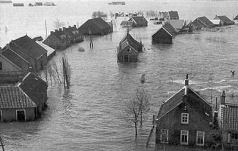 These works are known worldwide as the incredible "Delta-werken"
These works are known worldwide as the incredible "Delta-werken"
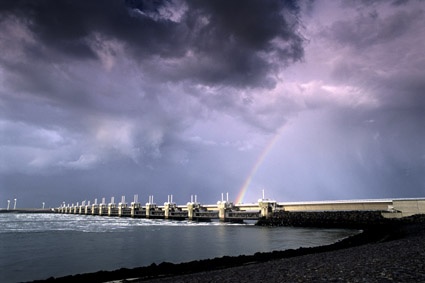
Above: Waterworks at Neeltje Jans. Between each pylon there is one panel which may move up or down. These vertical movement panels regulate the enormous tidal flows and harness spring floods. One may come very close to this water barrier at Neeltje Jans Waterworks Theme park. Photo by Neeltje Jans Theme park.

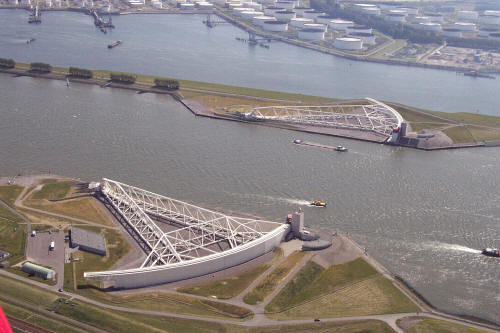
Above: Storm flood barrier built on a truly gigantic scale in the province of South Holland, the Maeslantkering Stormvloedkering in the Nieuwe Waterweg river, opened 1997. Address: Hoeksebaan, Hoek van Holland / Hook of Holland. Two enormous triangular hinging columns, arranged horizontally and stretching out 240 meters - nearly as high as the Eiffel tower. These harness two horizontal mega barriers which effectively block out high tides when fully closed. They protect the low lying Dutch polders of South Holland province.
The humongous hinges towards the left are anchored and hinged with ball-bearing spheres as they have to be able to turn both sideways and up and down with ebb and flood movements. This is the grand finale part of the Delta works which were started after the devastating flood of 1953 in the southern provinces of Zeeland and South Holland. One may visit this site. Photo by ANP press agency.
Polders and windmills as engineering marvels and landscape miracles, in Dutch and English.
The breath-taking line of historic windmills at Kinderdijk recall the many thousands of windmills in the Netherlands that once turned wind into power for the productive use of the Dutch people, for such wide ranging uses as water pumping, grain milling, or milling powders, papermaking, etc. One of these Kinderdijk mills is open to the public.
Other water and grain mills which may be visited are both in and near my North Holland home town of Alkmaar. With luck, you may even see the mighty horizontal and vertical turning shafts rolling into each other. This visit is a unique technological experience. Close proximity to the turning wheels would be considered too dangerous and thus be immediately prone to litigation in the USA.
Photo: Kinderdijk web site.
Map of Haarlemmermeerstraat, Amsterdam. Please note this tricky situation: there is another street in town that sounds almost the same: Haarlemmerstraat. You need however to go to my street, Haarlemmermeerstraat. Take tram 2 to Hoofddorpplein square or tram 1 to Suriname plein square.
You will both experience excitement and educate yourself while strolling along and talking technology with an art historian.
You will both experience excitement and educate yourself while strolling along and talking technology with an art historian. Before or afterwards you also have another option - after a ride in my car - to visit the historic centers of towns like Amsterdam (a sawing windmill), Alkmaar (one of the oldest windmills), Haarlem (rebuilt windmill and the largest steam pump in the world at Cruquius), Leiden (Windmill near Rembrandts birth home), Den Haag, Delft (University of Technology) and many other modern towns like the Rotterdam with its massive harbor.
Starting off at or near your hotel I will take you on a wonderful private cultural car tour of these waterworks - and I can get you to any of the other sites. This guided itinerary tour gives you a chance of some informed and intelligent conversation* (-; in a plain, accessible language (that is - in whatever language you choose to speak - Dutch, English or German. My French and Italian are rusty.)
I will be able to touch geographical, technological, architectural and cultural bases - including my academic field of fine art
You may also arrange this VIP treatment for business contacts or friends. This cultural organisation office will take care of a memorable experience.
* Drs. Kees Kaldenbach is your private "scholar-lecturer on culture tours".
One of my last clients, a journalist from the USA asked me whether I was a University professor and in which University I lectured. I am in fact an independent art historian, although I teach so now and then for the Emerson College, Boston.
*Martha Gellhorn, Travels with Myself and another, page 182.
Total time of this tour: after picking you up and getting you there (travel time to be calculated) it takes about 1/2 hours visit for Maeslant ; about 2 hours for Neeltje Jans, 1 hour for Kinderdijk.
Price: On request, to be calculated per person.
This tour is available upon request - please contact me to book a date. Bookings are required ahead of time. Minimum group size: 3 persons. Smaller groups are negotiable. Maximum: Groups will be limited to 8-10 persons. In that case my friend and colleague the geography teacher Drs. Noltes will join us.... Price per person is also lower in a larger group.
Photo by Dick Martin.
Drs. Kees Kaldenbach will be your private "scholar-lecturer on culture tours".
Further information is available on his web site: www.johannesvermeer.info
Map of Haarlemmermeerstraat, Amsterdam. Please note this tricky situation: there is another street in town that sounds almost the same: Haarlemmerstraat. You need to go to my street, Haarlemmermeerstraat. Take tram 2 to Hoofddorpplein square or tram 1 to Suriname plein square.
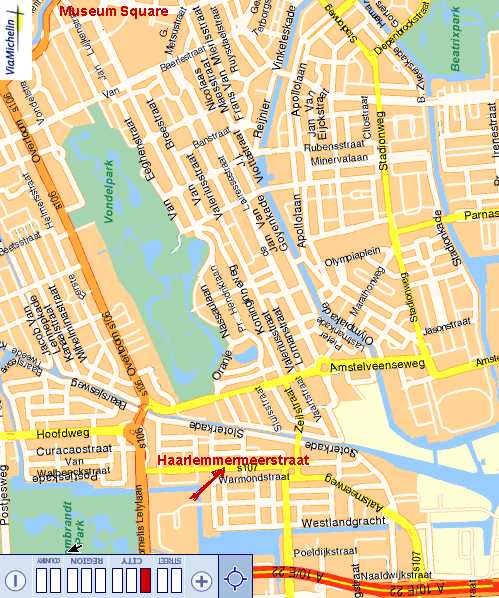
Contact information:
Drs. Kees Kaldenbach , kalden@xs4all.nl
Haarlemmermeerstraat 83 hs
1058 JS Amsterdam
The Netherlands
telephone 020 - 669 8119 (from abroad NL +20 - 669 8119)
cell phone 06 - 2868 9775 (from abroad NL +6 - 2868 9775)
How to get there:
- by car: ring road exit S 106 towards the centre, then 1st to the right (paid parking)
- by trams 1 and 17; exit at Surinameplein
- by tram 2; exit Hoofddorpplein.
From the museum square it takes a 10-minute tram ride.
Read client testimonials.
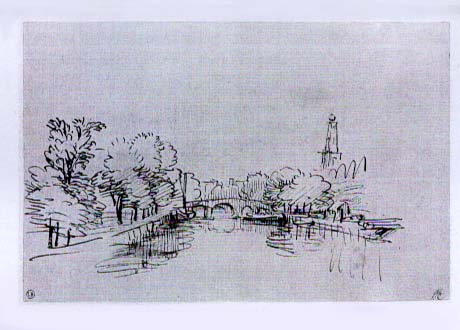
Reaction, questions? Read client testimonials.
Drs. Kees Kaldenbach, art historian, kalden@xs4all.nl Haarlemmermeerstraat 83hs, 1058 JS Amsterdam (near Surinameplein, ring road exit s106, streetcar tram 1 and 17).
Telephone 020 669 8119; cell phone 06 - 2868 9775.
Open seven days a week.
Member of VVV Tourist information and the Amsterdam Chamber of Commerce (Kamer van Koophandel).
E mail esponses and bookings to art historian Drs. Kees Kaldenbach.
This page forms part of the 2000+ item Vermeer web site at www.xs4all.nl/~kalden
Launched April 15, 2004. Updated July 29, 2016.
See Vermeer tours English and in Dutch/Nederlands
See Van Gogh tours